Hill Tribes - Northern
Thailand by Motorbike
-- Story by Erin --
Okay, so now "the folks" and
"the friends" have gone back home. After a few days of feeling kinda
weird, like being left behind somehow, we decide to go back up north again to explore it
more fully by motorbike. After extensively picking the brain of our new good friend
here in Chiang Mai, David Unkovich - author of A Motorcycle Guide to the Golden
Triangle, we hopped back on our bikes and headed to the Mae Hong Son area in the
Northwest (Note: The best map is the B&B Northern Thailand). Our
first stop was a village called Pai.
Now Pai is a bit deceiving at first sight.
As you pull into town it seems to be a sleepy little place in a valley between very
tall mountains. After we found the guesthouse we were looking for and unpacked we
decided to go out to have a look around town. All of a sudden we noticed a real
sizeable farang (foreigner) population walking around the streets as well.
Then we noticed lots of little guesthouses down alleyways, little cafes and shops, even a
few internet cafes! This is a regular backpacker hangout! Actually it's a
really good base to start treks, river rafting trips and off-road motorsporting into the
endless tracks and trails of the mountains.
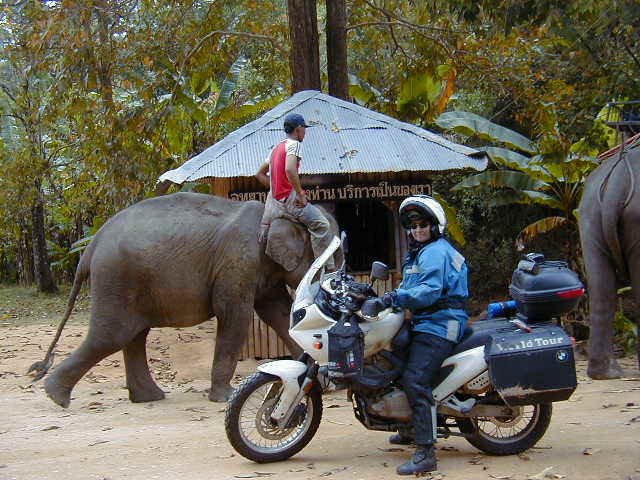
We stayed in Pai for a day and a half before
setting off just 40 kilometers down the road to an even smaller village called Sappong.
We had heard of a great little guesthouse called the T-Rex that we just had to take
a look at. The minute we saw it we fell in love. The place is nestled off the
main road on the banks of a small river. It is landscaped with huge banana trees,
mango trees, bougainvillea and other flowering trees and bushes. It is bordered by 9
little A-frame bungalows surrounding a beautiful pool. There is a nice little
restaurant serving Thai and German food (the owners are a German/Thai couple) in a lovely
wood/brick building, and the main house made of stone and wood has some larger VIP rooms
as well. There is even a huge (and I mean really big!) TV screen on the wall of the
living room of the main house. Here we spent our afternoons escaping the heat of the
day watching up-to-date videos. You know Chris was in heaven! We just can't
say enough about this place. Pen (the wife) and the staff were so gracious and
friendly that we would recommend this guesthouse to everyone.
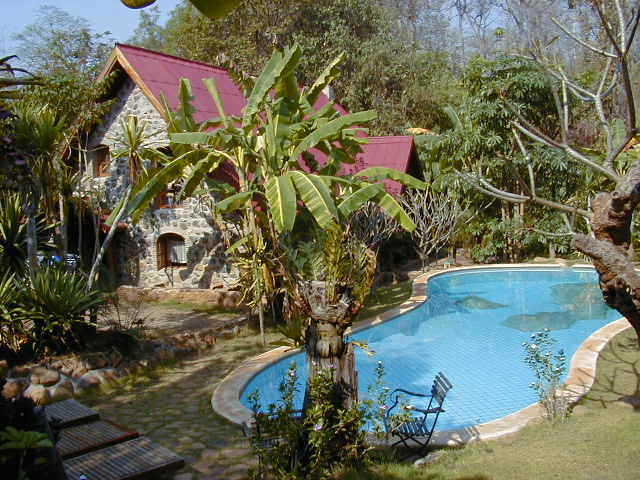 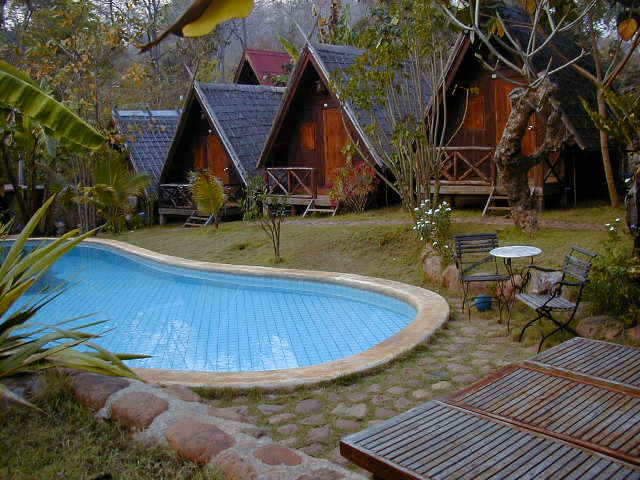
Sorry if that sounded like an advertisement.
We really did do some exploring here, not just sit by the pool and watch movies all
day (but of course we did that too.) Within easy walking or short driving distance
from Sappong are several caves (some of which are supposed to be the largest in the world)
that are filled with stalagmites and stalactites (do you know which is which?) and
centuries old wooden coffins (eerie), also there are a few waterfalls to see and many
footpaths which lead to very interesting and friendly hill tribes. We managed to see
all of these and do some off-road riding as well.
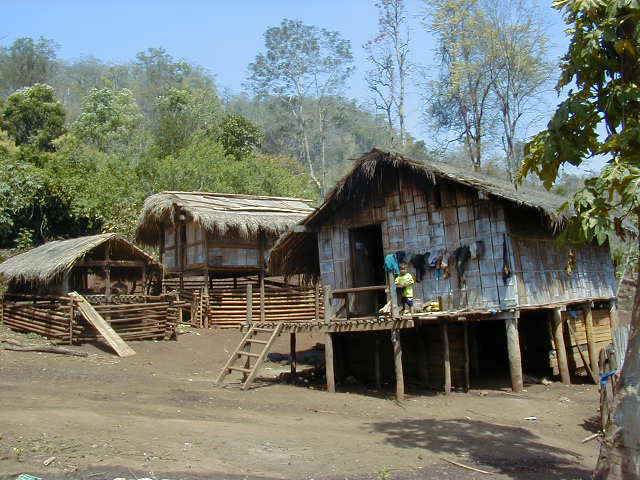
Many of the roads in the north leading to
the various hill-tribe villages are still dirt tracks that are mostly used by villager's
trucks and scooters, and would likely be inaccessible during the rainy season. Now,
in the dry season, these tracks are dry, dusty and can be deeply rutted in some areas.
It is challenging to drive these roads to say the least but oh-so rewarding when
you happen upon a village that rarely sees foreigners. The village people will stop
and stare and then smile and wave to us, especially the children. When we stop to
ask for something to drink the children practice their English on us. They love to
see the big bikes! Sometimes the women will bring out plastic bags full of their
hand-woven/stitched satchels, pouches, sarongs/skirts, blouses and pants to try to sell
them. Did I say they rarely see foreigners? Okay, they also see a fare share
of trekkers too I think. Anyway its all very quaint and you feel like you are
peering into life as it was many hundreds of years ago.
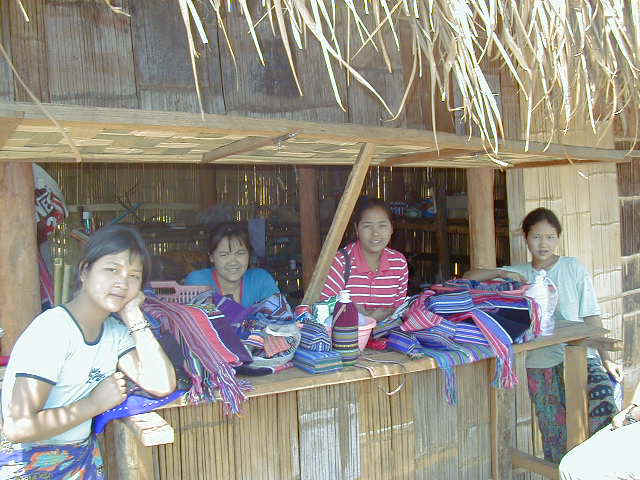
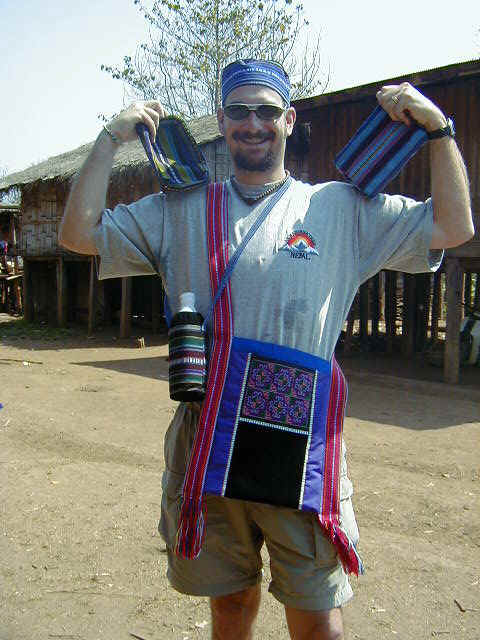
One day we decided to drive some dirt roads
recommended to us by some locals. At the beginning of the ride the dirt roads were
in great shape and very easy to handle. We drove for about 25 kilometers searching
for a village near the Burmese border. We ended up at the Burmese
border, in fact having missed a turn for the village somewhere that was denoted only Thai.
The friendly Thai border guards told us we could go no further 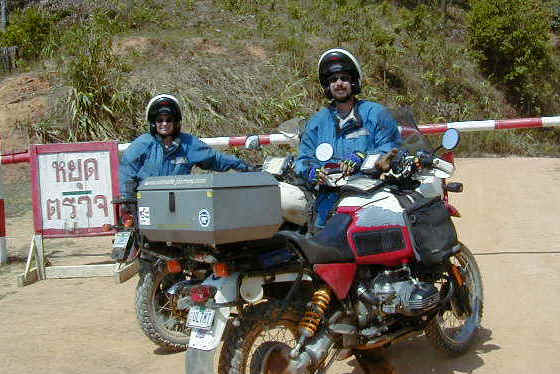 because
it was dangerous, but offered to take our picture. We backtracked along the road
until we got to a fork. We took the road that lead through a little village and then
over some mountains back in the direction of our guesthouse. The locals in the
little village said it was only about 15 kilometers of dirt road, in good shape (no
problem!) and we could not get lost as it was a direct road. Well, this is what
happens when you listen to locals some times...The road quickly turned to deep ruts and
rocks, was steep and twisty, and had numerous dirt tracks that branched off of it!
Thank God for GPS! It's what our friend David calls a class 3 dirt road (for experienced
bikers and 4WD only!) But, we made it just fine and with no problems----very proud
of ourselves. because
it was dangerous, but offered to take our picture. We backtracked along the road
until we got to a fork. We took the road that lead through a little village and then
over some mountains back in the direction of our guesthouse. The locals in the
little village said it was only about 15 kilometers of dirt road, in good shape (no
problem!) and we could not get lost as it was a direct road. Well, this is what
happens when you listen to locals some times...The road quickly turned to deep ruts and
rocks, was steep and twisty, and had numerous dirt tracks that branched off of it!
Thank God for GPS! It's what our friend David calls a class 3 dirt road (for experienced
bikers and 4WD only!) But, we made it just fine and with no problems----very proud
of ourselves.
After staying about 3 days in Sappong we
venture another 70 kilometers down the road (talk about twisties!), and up and over a few
mountain passes, we arrive at a rather large village called Mae Hong Son. This place
is known for it's misty mornings, although I never saw it, set in the mountains.
From here too you can explore the surrounding mountains and see many different hill-tribe
villages, temples, and caves and go river rafting on the Pai River. On our first
afternoon there we dropped our stuff off at a guesthouse and set off for a nearby
hill-tribe village with some fellow travelers, Emily and Mike, who we had met previously
in Chiang Mai and also in Sappong. They had rented an enduro style motorcycle in
Chiang Mai so we all went to this village together by motorbike. The village is
called Nai Soi and is a "Karen" village.
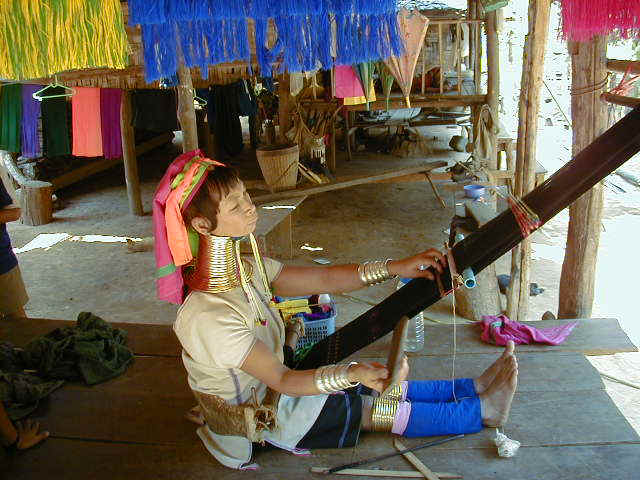
This particular tribal sect of Karen's has
an interesting custom for which they are also known as the "Long Neck Karen's".
The Long Neck Karen women place brass coils around their necks and below their
knees, which gives them the appearance of having long necks. This practice begins
around the age of 3 and they increase the number of with age, which may add up to 22 kilos
and be 30 centimeters in height. The coils actually do not elongate their necks but
press down on their collarbones and rib cage to give this effect. No one really
knows for sure how the custom got started. It might have been to protect the village
women from being killed by tigers carrying them off by their throats, or to discourage
outside men from finding their women attractive. Whatever the reason, this custom
still survives (but to a decreasing extent) today. As we toured their village I had
a gut feeling I was being a voyeur and it made me very uncomfortable (needless to say that
Chris took all the pictures). This particular village caters to tourism, charging
each tourist 250 baht ($7) to enter. The first few hundred meters on the main road
in town are lined with "Long Neck" women selling their hand-loomed garments and
items and demonstrating their weaving methods. As we left 4 mini-vans arrived filled
with very European-looking tourists, cameras at the ready! Exploitation or
not? I'm not sure.
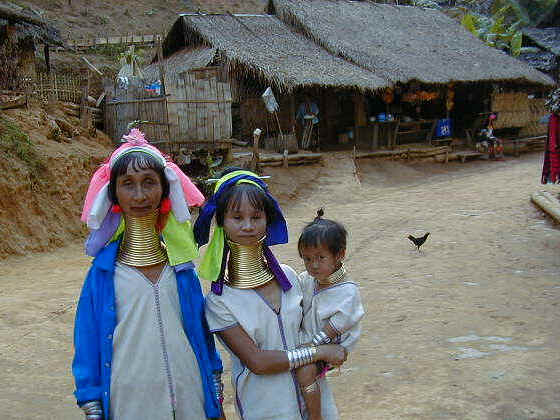
The next day we spent walking around town
and orienting ourselves. That evening we decided to see the sun set at a beautiful
white Buddhist temple set on a mountain top overlooking Mae Hong Son and the surrounding
mountains. It was indeed a beautiful sunset, making the sky red because of all the
smoke from the constant fires (set by the farmers to clear land). At the top we were
joined by two very nice German women, both riding enduro style rented motorbikes, on
holiday. As we watched the sun go down we all chatted about where we had been and
where we were going. We were to see them again a few days later back at the T-Rex in
Sappong.
Having seen most of what we wanted to see we
decided to drive back to Sappong and the T-Rex for some more R&R (hah! what a life).
We spent 3 more days there and then decided it was time to come back to Chiang Mai.
We had been told about a dirt road that we could take from Pai to Chiang Mai and
that stretched for 136 kilometers through the mountains and past many small villages.
Eager to have more off-road time experience under our belts before Laos and
Cambodia, we decided to try it out and hope for the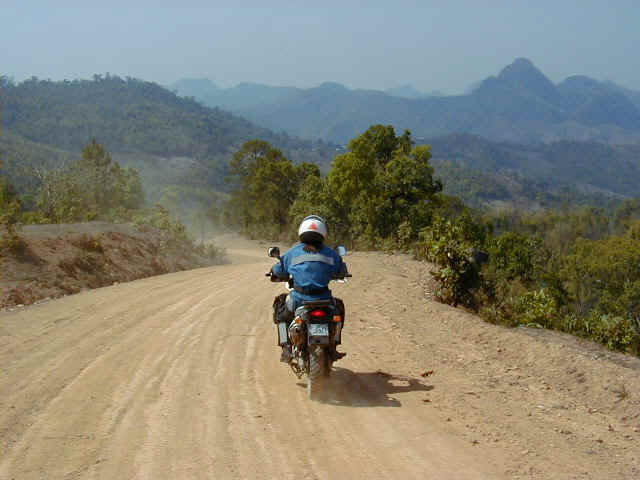 best. We found the turn-off for this road (the sign was only written in Thai) and
started off on what seemed to be a very good dirt road. Good dirt roads usually
don't stay "good" though as I discovered. I guess the term
"challenging" is a matter of experience and perspective. If you have a lot
of this kind of experience and ride a nice lightweight bike you would think this fairly
easy. For me, it was a REAL challenge. The road had several inches of
"bull dust" on it which is very deceiving because you never know if its an inch
or a foot and conceals rocks and ruts and all sorts of goodies underneath it. The
road is very steep at times and seems to go up-hill in a never-ending sort of way.
It was also very hot so my energy was being drained quickly, although we stopped for water
several times.
best. We found the turn-off for this road (the sign was only written in Thai) and
started off on what seemed to be a very good dirt road. Good dirt roads usually
don't stay "good" though as I discovered. I guess the term
"challenging" is a matter of experience and perspective. If you have a lot
of this kind of experience and ride a nice lightweight bike you would think this fairly
easy. For me, it was a REAL challenge. The road had several inches of
"bull dust" on it which is very deceiving because you never know if its an inch
or a foot and conceals rocks and ruts and all sorts of goodies underneath it. The
road is very steep at times and seems to go up-hill in a never-ending sort of way.
It was also very hot so my energy was being drained quickly, although we stopped for water
several times.
The apex of my day (about 3 hours into it)
was when I turned a corner going uphill (I was leading and making poor Chris eat my dust
the whole way) and saw what appeared to be some really deep sand in front of me. So,
drawing on my Enduro Park experience last summer, I throttled on through this stuff at a
good clip. Suddenly I hit a big rock hidden under the dirt, which caused the
candle bars to jerk out of my hands. The shock of it sent by body backwards so that
I hit my Givi topcase and totally lost control of the bike. My only thought at that
moment was "Oh shit, this is going to hurt." The next thing I know I'm
laying next to my bike on my back, spread eagle, and perpendicular to my seat. I
look up and realize that the bike had driven itself straight into a huge rut (must have
been about a meter deep - no fish tale story here!), resting on the saddlebags with the
front and back wheels suspended off the ground. I had been thrown off it and was
laying on the other side of the rut.
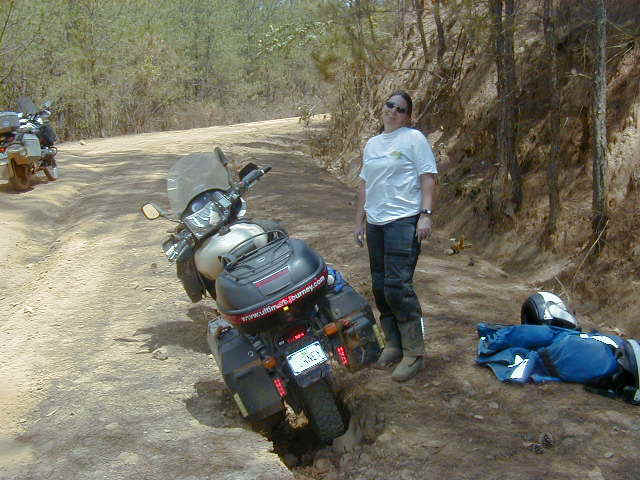
Chris of course sees all this happen and
comes running up to see if I'm okay. Then two young Thai's on a scooter come by and
offer to help. Since I happen to be the only one thinking straight at that moment I
suggest we first take a picture of it before digging the bike out. After we take the
picture we and one of the Thai guys manage to rock the bike out sideways and drag it just
far enough out of the rut to get it back on the rubber. Now I'm thinking,
"Jesus, I still have to drive this thing another 50 or so kilometers out of here in
this stuff?" Well, who else was going to do it? So, I shakily got back on
the bike and vowed never to go on these types of roads, for this distance and on these
heavy bikes, in the future if we know it exists in advance. The rest of the drive
was fairly easy in fact and we made it out without further incident.
Back in Chiang Mai again for a few days we
ran some errands and then decided to drive north again. Our 30-day visa was running
out in a day or so and we had to leave the country to get another 30-day visa for
Thailand. This is a quirky rule but everyone does the same thing, cross the border
into Burma, Laos, Cambodia or Malaysia and then return the same day to get another free,
30-day Thai visa. So we headed to Mae Sai, which is the northernmost city in
Thailand which borders on Burma. We left on March 13th and took the fast highway
road up. David Unkovich recommended that we stay in a great little guesthouse in a
small village just south of Mae Sai called Thoed Thai. David always has given us
good advice before so we took his direction and stayed there. The guesthouse is
called Rimtann and is run by a wonderful family. The husband, John, is originally
from Burma and speaks English very well. His wife is from Laos. John had
worked for Americans in Laos 15-20 years ago (CIA maybe?) and his English definitely has
an American accent.
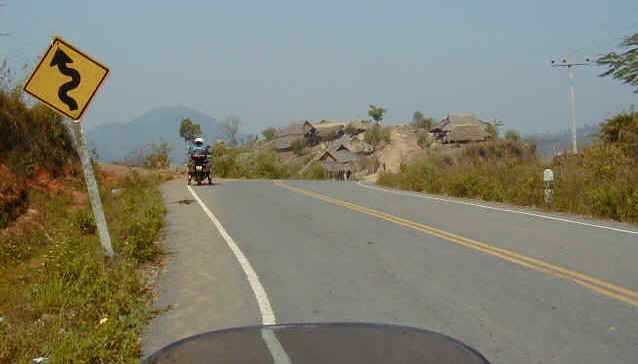
The first night there we rested in
hammock-like bamboo chairs outside our bungalow on the bank of the river. Across the
river was a Catholic church with much activity and children playing. Just up the
river was a sturdy looking suspension bridge with both people and motorcycles/scooters
making there way across it. As the sun began to set the local fishermen came out
with their nets in the hopes of fish for dinner, but we didn't see them catch anything.
We decided to venture out into the village in search of dinner. As we passed
through the garden we saw a banquet party gathered there, mostly women from the village.
We were immediately spotted and escorted to the table to join them. They
fixed us appetizers, made us sample most of the dishes on the table and poured us beer.
John explained to us that this party was to celebrate the reelection of his wife as
chairperson of the local Women's Mutual Support Committee. His wife had been
chairperson for over ten years and they wouldn't let her retire! It was such a
lively group, many of the women trying to speak to us in their limited English and explain
the professions of each of them. It turns out that the Women's Committee is a really
large association of over 500 women from the village. Their goal was mutual support,
encouragement and tangible help in getting work for immigrant and refugee women in the
community. They really inspired me! I thought, if I was ever to settle
anywhere to do volunteer work, this would be the place for me.
The road to Thoed Thai is beautiful twisting
roads up and down steep mountains. The road into Thoed Thai is unfortunately
littered with potholes and is extremely dusty. The day after we arrived was
the 13th of March and our last day of our Thai visa. We headed for the Burmese
border and Mae Sai by following a paved, be extremely narrow, road directly along the
Burmese border. We thought it would be spectacular and it was! It is one of
the most fun and scenic roads we've been on yet in Thailand. Although the road has a
painted yellow line down the middle to separate the lanes, no two cars could pass at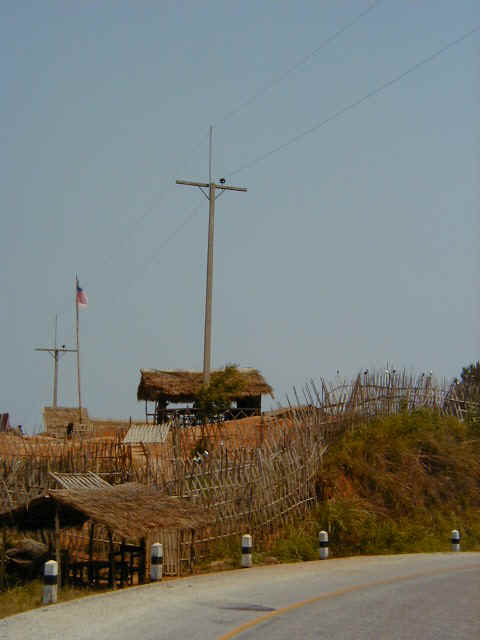 the same time. It was more like driving on a bike path and it
twisted very sharply almost the entire way. We passed many small villages with
children laughing and waving at us, brightly dressed villagers coming and going from
working in their fields, and Thai Army lookout posts watching the Burmese border very
closely. As we drove along the ridge we could see many small Burmese villages on the
other side. We also passed a Burmese Army post along the road, on what looked to us
like Thai territory! According to our friend David, since things have heated up
between the Thai's and Burmese lately the Burmese have staked their claim to an electrical
pole along side this road which they claim is on their territory. It was a strange
sight indeed to see an army camp whose sole purpose it to guard an electrical pole! the same time. It was more like driving on a bike path and it
twisted very sharply almost the entire way. We passed many small villages with
children laughing and waving at us, brightly dressed villagers coming and going from
working in their fields, and Thai Army lookout posts watching the Burmese border very
closely. As we drove along the ridge we could see many small Burmese villages on the
other side. We also passed a Burmese Army post along the road, on what looked to us
like Thai territory! According to our friend David, since things have heated up
between the Thai's and Burmese lately the Burmese have staked their claim to an electrical
pole along side this road which they claim is on their territory. It was a strange
sight indeed to see an army camp whose sole purpose it to guard an electrical pole!
We finally made it to the border, had our
passports stamped out of Thailand, paid our $5 US to cross into Burma and had lunch.
The small town on the Burmese side called Tachilek is a typical border town with
people trying to hawk everything imaginable. We decided to have a look at the market
but after a half hour, decided it looked like all the other markets in Thailand, with
nothing new to offer. Not much interested me about this little trip across the
border but one thing did fascinate me. At least in this little border town in Burma,
the faces of the Burmese people differed widely, more so than in Thailand. In
Tachilek, I saw many people who looked more Indian to me and I found myself staring at
their faces. Also, most of the men were wearing madras lunghis (long sarongs)
instead of pants like they do in India. You don't see this (at least not often) in
Thailand. I was amazed at this difference, especially considering there is no great
distance between them and that Burmese and Thai traders cross the border regularly for
work.
We left Mae Sai in the early afternoon and
decided to visit the Royal Villa and Gardens on Doi Tung (doi means mountain),
which was on the way back to Thoed Thai. The Royal Villa and Gardens were built for
the King's mother (the Princess Mother) as she spent much time here. She is
especially loved by the hill-tribe people for the development work she's done for them.
We did not go in the Villa as other tourists told us it was more Swiss Chalet in
style and not as stunning as the gardens. So we spent an hour or so wandering
through the beautifully landscaped gardens and relaxing in the shade of different
flowering trees. The Thai's so love their gardens that you see them everywhere,
including surrounding insignificant government buildings and offices in the countryside.
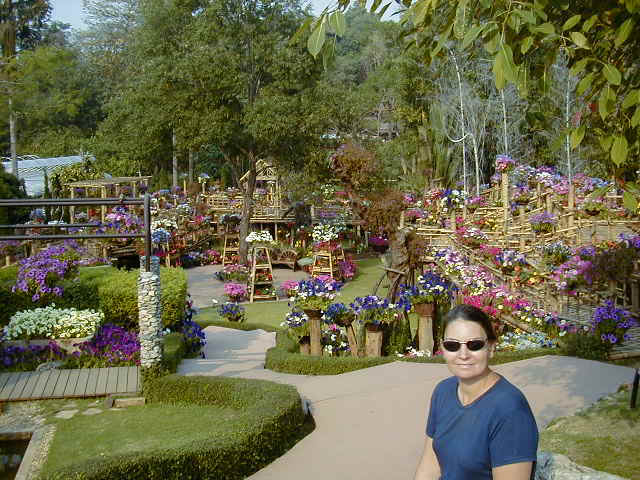
We spent that night again in Thoed Thai and
the next morning decided to explore the village a little bit before leaving. At
John's suggestion we strolled through the morning market and saw the wonderful produce
vendors, fish and meat sellers, the general store vendors and of course, the fried food
vendors. We ate doughnut-like fried dough for breakfast and some tangerines for a
little nutrition. After we got to the end of the market we saw a sign pointing to
the compound/museum for Kung Sa, the Opium Drug Lord's hangout. He is supposed to be
world-famous, although probably more with the Vietnam-era generation. Anyway we
found it and wandered around the empty buildings a bit. Unfortunately it had not
opened yet and we did not get to see the exhibits inside the little museum part of it.
We returned to the guesthouse and said goodbye to John and his wife, and promised
to send more bikers and tourists to their lovely place.
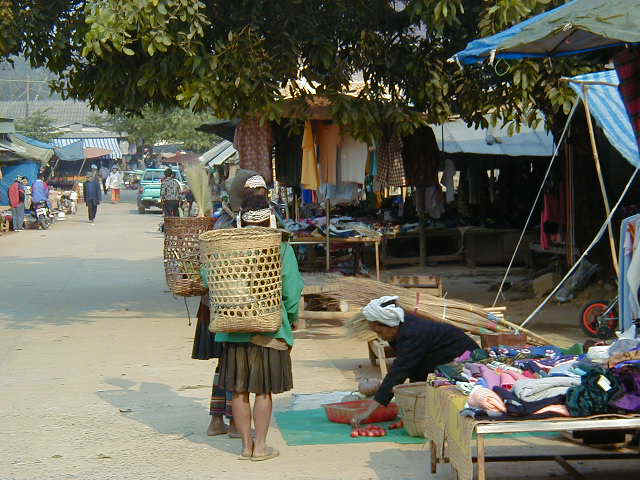 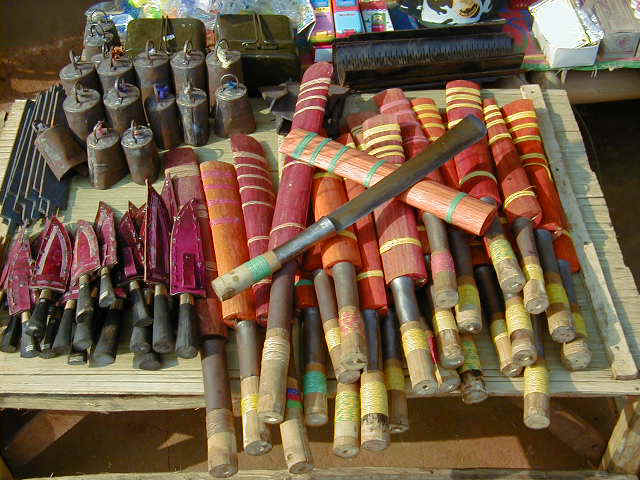
We again took the fast highway route south
and decided to stop in Chiang Rai instead of going directly back to Chiang Mai.
Chiang Rai is probably the second largest city in the North. We found a nice little
guesthouse somehow secluded but directly in the center of town. We wandered around
in the hot afternoon and explored the fun Night Bazaar that evening. This Night
Bazaar is especially good I think because it is not so tightly packed with vendors and
tourists (like the one in Chiang Mai is), has a variety of food and beverage vendors, two
large eating areas with tables and chairs, and has two stages with live performances of
local music and dance. It was more casual than harried, and many locals mingled with
tourists to enjoy it all.
The next day we left for Chiang Mai (again!)
and now here I am writing this latest chapter. Our plan now is to service the bikes,
get our visas for Laos, and run some last minute errands before crossing the border at
Vientiane. In the meantime, we are also enjoying the pool at our guesthouse and the
nearby movie theater! One side note about the movie The Beach: Don't think that all
of Thailand is like that! Although the south might have that bohemian party
reputation I don't think it's as bad as portrayed in the movie. The north certainly
isn't like that. But, we'll find out first-hand sometime in May when we expect to be
there!
P.S. About 25kms south of Chiang Rai, we
stopped in at the Charin Garden Resort. We had been there once before, and this time
we had some of their famous pie(s) for breakfast -- Hey, you got to live a little! |